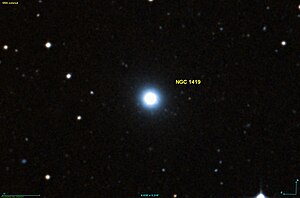NGC 1419
| Galaxy NGC 1419 |
|
|---|---|

|
|
| AladinLite | |
| Constellation | Eridanus |
|
Position equinox : J2000.0 , epoch : J2000.0 |
|
| Right ascension | 03 h 40 m 42.1 s |
| declination | -37 ° 30 ′ 39 ″ |
| Appearance | |
| Morphological type | E. |
| Brightness (visual) | 12.5 mag |
| Brightness (B-band) | 13.5 likes |
| Angular expansion | 0.9 ′ × 0.9 ′ |
| Surface brightness | 12.3 mag / arcmin² |
| Physical data | |
| Affiliation | Fornax cluster LGG 96 |
| Redshift | 0.005314 ± 0.000067 |
| Radial velocity | 1593 ± 20 km / s |
|
Stroke distance v rad / H 0 |
(66 ± 5) x 10 6 ly (20.1 ± 1.4) Mpc |
| history | |
| discovery | John Herschel |
| Discovery date | October 22, 1835 |
| Catalog names | |
| NGC 1419 • PGC 13534 • ESO 301-023 • MCG -06-09-017 • 2MASX J03404211-3730390 • SGC 033851-3740.3 • GALEXASC J034041.98-373039.1 • FCC 249 • LDCE 249 NED034 | |
NGC 1419 is an elliptical dwarf galaxy of the Hubble type E0 in the constellation Eridanus in the southern sky . It is an estimated 66 million light years away from the Milky Way and about 15,000 light years in diameter . It is listed as a member of the Fornax Galaxy Cluster under catalog number FCC 249 .
The object was discovered by John Herschel on October 22, 1835 .
